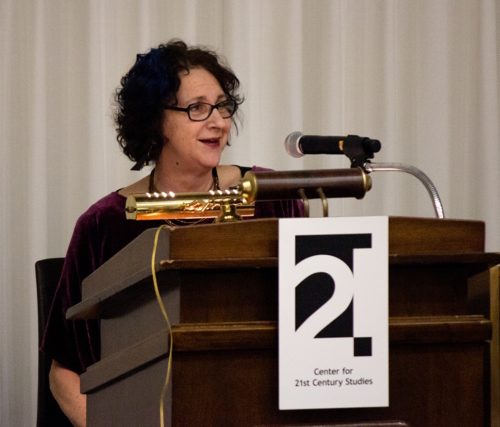
Back on the University of Wisconsin-Milwaukee’s campus after nearly two months away, I am once more tucked into my favorite nook in Curtin 175 while I eagerly await Jane Gallop’s talk on her recently released monograph, Sexuality, Disability, and Aging: Queer Temporalities of the Phallus (2019, Duke University Press). This work promises to connect several intersecting arenas of research that seldom meet: queer theory, disability studies and studies on aging. Not one to disappoint, Gallop begins by noting that there is virtually no work to be found at the intersection of queer theory and aging. While pieces such as, “The old, the ugly, and the queer” by Sandberg (2008) and “Gender transitions in later life” by Fabbre (2014) exist and are circulated within programs such as the one I teach in, LGBT+ Studies, it is admirable of Gallop to draw the audience’s attention to how queer theory and queer thinking as they relate to disability studies may grant deeper insight into notions of aging and temporal normativities.
Gallop weaves together queer theory’s penchant to question norms with notions of aging as “late onset disability” by noting that the norms surrounding what it means to exist, move, and participate in the world, and more specifically to engage in any form of sex, tend to exclude and “castrate” older people struggling with mobility, dexterity, etc. This claim proves intriguing, though not entirely satisfactory. An admitted novice with regards to the literature surrounding disability studies, I nevertheless take in Gallop’s discussion of the struggles of aging as disability quite warily, hesitant to conflate disability with the process of growing older, particularly given many of the inconveniences of growing older do not equate to the marginalization people with disabilities face throughout their lives. Indeed, Gallop takes issue with the fact that people born with disabilities are so predominantly featured as the sole image of disability in popular culture and academic research that those facing “late-onset disability” are erased. I do not agree with Gallop’s statement entirely as it nears a “1+1=2” reading of intersectionality by seeming to claim that to have a disability and be older is to face more marginalization than those who live their entire lives with disabilities. In part due to this claim, I am at first unconvinced that the inconveniences of old age are a form of disability and, throughout the talk, remain hesitant to fully accept the term “late onset disability.”
I am certain that part of my hesitation to join Gallop’s journey of synthesizing queer theory, disability studies, and notions of aging stems from my training as a queer anthropologist. Gallop’s claims that the sexuality of older people faces societal and normative erasure, as well as her observation that the norms that marginalize people with disabilities seem to also oppress those experiencing forms of disability brought about by aging, are apt and well-taken. Seldom would a queer anthropologist hesitate to agree with this assessment. That being said, the manner in which she arrives at this conclusion is markedly different from those with which I am familiar.
Taught to cede analyses based in opinion to those founded on ethnographic research and to base theory not in literary analysis but in lived experience, I am admittedly lost when Gallop’s talk turns to a reading of Lady Chatterley’s Lover as example of “late onset disability” and “castration anxiety” à la Freud. Accordingly, I will not address this portion of her talk, though I imagine it proved fruitful to those humanities scholars in the room with me. I will note that certain phrases she utilizes throughout her analysis of the work appear to conflate categorizations of social groupings in order to further her argument. I remain unconvinced that Lord Chatterley’s sexual encounter is equivalent to Gallop’s “late onset disability,” though it does highlight the normative manner in which we are encultured to think about sexuality and sexual encounters.
As Gallop nears the end of her talk, I am left wondering if her concept of “late onset disability” is a conflation of lived experiences or if it will prove to be a useful analytical tool. I am nevertheless reminded of the utility of queer theory in all its forms and am now aware of the need for further research into how queer theory might be able to shed light on processes and norms surrounding aging.